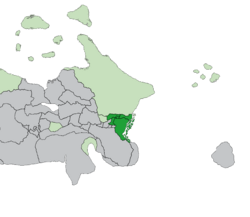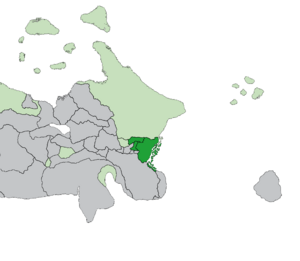Emerstarian Canaria: Difference between revisions
RobotSpark (talk | contribs) No edit summary |
|||
| Line 103: | Line 103: | ||
{{Emerstariantopics}} | {{Emerstariantopics}} | ||
[[Category:Emerstari]] | [[Category:Emerstari]] | ||
[[Category:Markion]] | |||
Latest revision as of 00:12, 3 September 2021
| Emerstarian Canaria Emeers Kanaarlanden Emerschekanaaren Emerskkanarien | ||||||
| Real union of the Emerstarian Empire | ||||||
| ||||||
| ||||||
| Motto "Voor God, dan Koning en Land" "For God, then King and Country" | ||||||
| Anthem "Kuingettssjung" "The King's Song | ||||||
| Scania Peninsula in 1692 – Emerstarian Empire (green and dark green) – Emerstarian Canaria (dark green) | ||||||
| Capital | Kralendijk | |||||
| Demonym | Emerstarian Canarian | |||||
| Government | Federal Parliamentary Constitutional Monarchy | |||||
| Monarch | ||||||
| • | 1669–1690 | Gustaf II Jakob | ||||
| • | 1835–1841 | Folke II Knudt | ||||
| First Representative | ||||||
| • | 1672–1685 | Cornelius van der Bijl (first) | ||||
| • | 1835–1842 | Johannes de Vries (last) | ||||
| Legislature | Rijksraad | |||||
| • | Upper house | Kamer van de Heeren | ||||
| • | Lower house | Kamer van de Volk | ||||
| History | ||||||
| • | Death of Lodewijk III | 27 April 1672 | ||||
| • | Personal union between Emerstari and Canaria–Luksen | 4 June 1672 | ||||
| • | Emerstarian annexation of Fluindery | 28 February 1697 | ||||
| • | Restoration of the House of Eric | 25 December 1718 | ||||
| • | Real union between Emerstari and Canaria–Luksen | 16 March 1721 | ||||
| • | Goenspijk Declaration | 4 November 1841 | ||||
| • | Death of Folke II Knudt | 21 April 1849 | ||||
| Today part of | Canaria | |||||
Emerstarian Canaria (Emerstarian: Emerskkanarien; Canarian: Emers Kanaarlanden; East Low Rhenish: Emerschekanaaren) was the collecive name of three Canarian states with which the Kingdom of Emerstari and ther later Federal Republic of Emerstari held in a real union from 1672 to 1841. This region was comprised mostly of the eastern half of the modern nation of Canaria, as well as parts of northwestern Roele from 1672 until 1768 with the capital being Kralendijk.
Canaria-Luksen had been inherited by the Emerstarian House of Leijonhuvud from the extinct House of Le Poer upon the death of Lodewijk III of Canaria-Luksen in 1672. Soon thereafter, during the reign of Karl IV Lorens, Emerstari and the Duchy of Fluindary into a personal union, expanding their Canarian territory. When Erwin III Karl died in 1718, the Emerstarian throne and thus Emerstarian Canaria was passed to his third cousin Eric VIII Olaf, who was the ruler of Deischtland, Schvauner, and Hüllen, three Canarian duchies. In 1768, the provinces of Çaunté and Roussioné were ceded to Roele in accordance to the Treaty of Mïechy; however, the remainder of Emerstarian Canaria stayed under Emerstarian rule until the Treaty of Goenspijk in 1841.
History
Fluindary expansion
The childless Philip VI of Fluindary shortly before his death in 1694 converted to Protestantism and declared in the Edict of Oest that a Catholic should not succeed him as Duke of Fluindary. His younger brother, Albrecht van Damme claimed that Fluindary's Landelijksdag had already declared that he was Philip's heir, that the monarch could not change succession laws without the approval of the Landelijksdag. Karl IV Lorens of Emerstari, however, claimed there was no such protocol and that he, as Philip's closest Protestant relative, was the rightful heir to Duchy of Fluindary's throne. In response to Karl IV Lorens, the Catholic Louis XIII of Marseile stated that he would end his support for Emerstari in the War of the Müncken League if he did not forfeit his claim. Thus, the Emerstarian Hus av Herrer and Hus av Folk both demanded that Karl retract his statements and support Albrecht van Damme as Duke of Fluindary.
In 1710 the son of Albrecht, who had succeeded his father as Duke, Frederich's wife suffered a miscarriage. This again brought attention to Fluindary, and the nephew of Karl IV Lorens, Erwin IV Karl of Emerstari intended to invade Fluindary had he the casus belli. Frederich, later that year, had his wife murdered, and quickly remarried, to Katherine von Tresck who in 1713 bore Frederich a daughter. Fearing that a Protestant revolt would ensue if he did not have a legitimate heir, Fredrich asked the Landelijksdag to change the succession laws of Fluindary to include women. This, however, only worsened his image. Furthermore, it was soon made known that his first wife had not died of smallpox but was ordered to be murdered by Frederich. A Protestant revolt ensued and deposed him as Duke. The Protestant rebellion, which now controlled the nation, requested that Erwin IV Karl become Duke of Fluindary. Erwin accepted and in 1714, before reestablishing the Landelijksdag, he issued the Iltsch Edict that granted Catholics the ability to practice their religion freely so as to reduce the tension between both sects.
Edict of Noordsrecht
Eric VIII Olaf shortly after his ascension to the Emerstarian throne issued the Edict of Noordsrecht wherein he declared his support for stronger political ties between Emerstari and Emerstarian Canaria and urged the legislative bodies of Emerstari, Canaria–Luksen, Fluindary, Flaamsia, Schvauner, and Deischtland to vote for a transformation into a real union. By late–Summer of 1720, three months after his edict, each nation's legislatures had convened to discuss and vote on the issue. The legislatures of Emerstari, Canaria–Luksen, Flaamsia, Schvauner, and Deischtland all approved of his edict. However, the Fluindish legislature disapproved of the motion, primarily due to the nation's Catholic majority. Eric VIII Olaf responded by disbanding the Landelijksdag which further agitated Catholic Fluindish.
Retaliation
Van Lynden, a Catholic Fluindish count supported by a cabal of other nobles, led a revolt against Eric VIII Olaf, besieging the city of Aalst, for it held a garrison of 5,000 regulars. A week into the siege, news of it reached Rensulier, whereafter Eric VIII Olaf summoned together five regiments of Karlinera from the Royal Life Guard and against the advice of his Privy Council and his friend Karl Jakob Fjellborg, Duke of Vattenland, the Hogherre, led them himself to Fluindary. By the time of his arrival, the Siege of Aalst was lost. Eric, en route to Ghijtt, a town west of Aalst, came upon the 3,400 regulars that retreated from Aalst. Captain-Lieutenant Anders Jakob Ekdahl, the officer who ordered the retreat, was relieved of command by the King and he ordered the regulars to act as his rearguard during his march to Ghijtt.
On October 7th, the whole of van Lynden's army (~16,000) besieged the town of Ghijtt whereat were 12,400 Emerstarian and pro-Emerstarian soldiers. On the third day of the siege, arrived Luksesh reinforcements for the Emerstarians. On the fifth day, Emerstarian forces sallied from the castle, and with the Luksians, attacked the Catholics from both sides. During the engagement, van Lynden and one of his co-conspirators died from stray musket fire. Ultimately, Eric VIII Olaf pardoned the army of van Lynden; however, he ordered for the remainder of van Lynden's co-conspirators to be killed by firing squads. In the April of 1721, the Landelijksdag was resummoned and they voted again on the Edict of Noordsrecht, approving of it, for it now consisted mostly of Fluindary's Protestant nobles and those fearing another further invasion of Fluindary by Emerstari.
Treaty of Mïechy
The Igues War, which had been being fought between Emerstari and Marseile between 1765 and 1768 had come to a stalemate, and thus, delegations of the two nations met in the Marseilian city of Mïechy in order to conduct peace talks. The Treaty of Mïechy resulted from this. It was signed on the 17th of July, and it required Marseile to give to Emerstari the islands of Cullakuti, Loyuti, and Berrulwi while it required Emerstari to cede the provinces of Çaunté and Roussioné, within Emerstarian Canaria, to Roele, which was in a real union with Marseile.
Treaty of Goenspijk
Following the end of the Wars of the Coalitions in 1831, Emerstari was progressively loosening its grip over its continental possessions including Hüllen (1832), Hussea (1873), and Soumeland (1904). Emerstarian Canaria, which had mostly been consolidated into one nation at this point, was being given more autonomy as well. Several movements existed within Emerstarian Canaria supporting this. However, these groups each wanted different levels of autonomy. The Groep Voor Kanaarlands Gelijkheid (Canarian: Group for Canarian Equality), a political party founded in 1830 strove for a return to a personal union wherein Canaria would be equal to Emerstari as opposed to being a lesser partner of a real union. The Onafhankelijkheid Partij, founded in 1827, strove for complete independence from Emerstari and unity with Roechelen, which today forms western Canaria. By the end of the 1830s, these parties held pluralities in the Rijksraad, and officials from Emerstari met with them. In the Goenspijk Building in 1841, an agreement was reached and the Treaty of Goenspijk was written declaring Canaria would be an equal partner with Emerstari in a personal union until the death of Folke II Knudt of Emerstari, whereupon an individual selected by the Rijksraad would be made Monarch of Canaria. In 1849, after the death of Folke II Knudt, Johan Laurens, Duke of Deischtland, great-great-great-grandson of Emerstarian king and president Olaf III Aleksender, was crowned King of Canaria.




